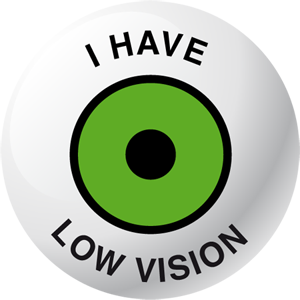
The I HAVE LOW VISION badge, and the resulting dissemination campaign, came into being at the end of 2013 as a response to the need observed by various organisations representing the visually impaired in Spain. The need identified was that of educating the public as to the existence of those who, without being completely blind, have serious visual problems. Through this initiative, we seek to find a method of making these people visible within society, achieve better understanding and assistance from others regarding their difficulties, and so facilitate their social integration.
Most people regard vision as something that you either have or you don’t, and that poor vision can be corrected with glasses or surgery. It is difficult to understand that a person in some situations may show no difficulty, and in others they require assistance or the use of a white cane. It is particularly true for visual field defects, so-called “tunnel vision”. This means that a person may need help to walk or orient themselves, but may then read a newspaper or use their mobile telephone.
Often, people with visual impairment feel misunderstood when carrying out normal, daily activities. To others, they may perhaps seem to move excessively slowly or behave strangely. This is more so when we consider that some people with visual impairment show no outward signs of this disability: no abnormality in the appearence of the eye itself, they are able to directly look at people or objects, they wear no dark glasses or any other signal of vision problems.
We decided to create a system to make people with low vision recognizable as such. Throughout the process, we discovered that similar systems work well already in other European countries like Germany and Austria by using badges and armbands. This gave us great hope to move forward with the idea. Usually, this identifying function of visual impairment is carried out with a white cane, which of course is also useful to detect obstacles. However, white canes are associated with total blindness, and the population is not aware of the spectrum of visual impairments affecting day-to-day activities.
By presenting “I HAVE LOW VISION”, we hope that the general population can identify and understand why the people affected move slowly, may need help with certain tasks, and may behave strangely in some situations due to their disability (such as: not recognising someone on the street, tripping frequently and easily...). These situations can lead to great misjudgements (mistaking individuals for rude, eccentric or even drunk…).
We believe that this system is useful and complementary to the white cane. In fact, many habitual white cane users may not use it in environments they are very familiar with, or those with good lighting. When not using their cane, they may still wish to identiy themselves as visually impaired. The other advantage is that they have their hands free (for example, when shopping in a supermarket).
It is a non-profit initiative and none of the associated parties obtain economic benefits from the sale of the badges. The price is the cost price of production and postage, and any donations or grants obtained for the campaign are integrally used for dissemination and expansion purposes.

